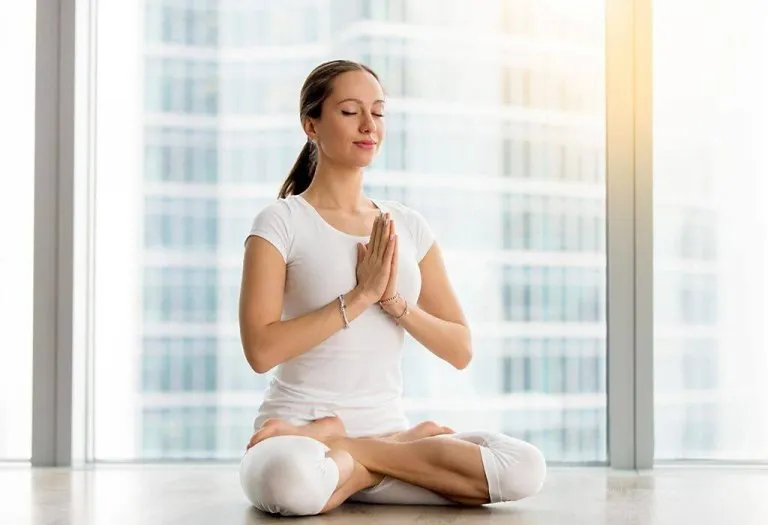First Trimester Yoga – Benefits and Poses to Try
- Is It Safe to Practise Yoga in the First Trimester of Pregnancy?
- Benefits of Practising Yoga in the First Trimester of Pregnancy
- Yoga Routine to Follow During the First Trimester of Pregnancy
- Yoga Poses/Asanas You Can Try in the First Trimester
- Yoga Poses to Avoid During the First Trimester
- Yoga Tips to Keep in Mind During the First Trimester
- FAQs
Pregnancy is an exciting and transformative journey. Maintaining physical and mental health from the beginning is crucial for your baby’s healthy growth and development. During the initial weeks, you may experience morning sickness, nausea, and other tiring pregnancy symptoms; exercise and yoga can prove to be a boon at the time. Incorporating yoga in the first trimester of pregnancy can provide a gentle and nurturing way to support your body’s changes and alleviate discomfort. Keep reading to learn more about the numerous advantages of first-trimester yoga for pregnant women and and which yoga asanas are safe to be performed in the first three months of pregnancy.
Is It Safe to Practise Yoga in the First Trimester of Pregnancy?
Yes, yoga can be safely practised during the first trimester of pregnancy, but only under the guidance of a certified yoga instructor aware of your health. Specific asanas and poses may inhibit the uterine blood flow and cause sprain or muscle spasms. Hence, yoga asanas should be practised with caution and under the guidance of a yoga instructor. You should also consult your gynaecologist before you start practising yoga (1).
Benefits of Practising Yoga in the First Trimester of Pregnancy
Practising yoga for the first trimester of pregnancy offers numerous benefits, including enhanced physical and emotional well-being. Let’s look at a few key benefits.
1. It Can Help Keep Unhealthy Habits at Bay
It’s pretty much imperative that you have to let go of unhealthy eating habits and lifestyle during the first trimester of your pregnancy for the sake and well-being of your developing baby. Yoga helps you let go of toxic emotions and cope better with letting go of unhealthy habits like overeating/anorexia, smoking, alcoholism, and insomnia.
2. It May Provide Relief from Pain
Yoga provides relief from pregnancy pain. Practising safe yoga asanas can help you cope better with the pain during the three trimesters. Breathing techniques can also help you stay relaxed and stress-free during pregnancy (5).
3. It May Strengthen Mind-Body Connection
If you’ve struggled with mindfulness, practising yoga can help. By practising yoga, you will become mindful of the life growing inside you and learn how to let go and live in the moment. Yoga can also improve your mood and make you emotionally strong (7).
4. Physical Activity
Engaging in other forms of physical activity is important to stay healthy during pregnancy and even otherwise. While pregnant, practising simple yoga asanas can ensure that you stay physically active and relaxed at the same time.
5. It Can Help Improve Your Sleep Pattern
Women who experience sleep-related issues during pregnancy can significantly benefit from yoga. Yoga regulates sleep patterns and assists in hormonal imbalances, thus improving sleep quality.
Yoga Routine to Follow During the First Trimester of Pregnancy
Some things to incorporate into your yoga routine during the first trimester are as follows:
- Avoid strenuous yoga exercises in the first trimester of pregnancy, and do not stretch beyond your natural range of motion.
- Listen to your body and be aware of pain and signals.
- Rest whenever you want.
- Do not practise yoga in hot weather or when you are not keeping well.
Yoga Poses/Asanas You Can Try in the First Trimester
Below are some yoga poses that can be practised during the first trimester of pregnancy. Although these are pregnancy-safe yoga asanas, we suggest that you check with your doctor before you start practising them (2).
1. Bhujangasana

Bhujangasana is a simple yoga pose, also known as the cobra pose. When practising this pose, don’t push yourself too hard and don’t hold it for more than 30 seconds.
How to Do
- Lie on your stomach with your forehead facing the floor.
- Keep your feet at a hip-width distance.
- Keep your elbows close to the body and place them underneath your shoulders.
- Retract your shoulder blades to the back and draw your pubic bone towards the floor for stability.
- Gently inhale and lift your head and chest off the floor. Relax your shoulders, and don’t exert your entire body weight downwards.
- Exhale and slowly lower yourself back to the ground.
- Do 4-5 reps.
Benefits
This pose can help release lower back tension, improve mood, and increase overall flexibility.
2. Baddha Konasana

Baddha konasana, commonly known as the butterfly pose, resembles a butterfly flapping its wings. It is best practised on an empty stomach.
How to Do
- Sit straight (or as comfortably straight as possible) and stretch your legs outside.
- Inhale gently and bend your knees as your heels are pulled towards your pelvis.
- Lightly press the soles of your feet together, allowing your knees to drop gently to the sides.
- Lift the heels towards your pelvis as close as possible and hold your feet with your hands.
- The outer edges of the feet must be planted on the floor, and your torso should lengthen across the sternum.
- Hold the pose for five minutes and lift your knees, extend, relax and return to your original position.
Benefits
This pose helps reduce fatigue, stimulate the adrenal glands, treat menstrual problems, and improve overall blood circulation.
3. Bitalasana

Bitalasana is known as the ‘Cow Pose’. This pose is usually practised with a cat pose and is a beginner-level asana.
How to Do
- Get on all fours in a tabletop position.
- Your wrist should be in line with your shoulders, and your head must be between your hands.
- Gently inhale and lift your buttocks towards the ceiling, thus opening the chest.
- Sink your abdomen towards the ground and lift your head.
- Hold for a few seconds, exhale and return to the tabletop position.
- Repeat this sequence five to six times.
Benefits
This pose relieves stress, massages the internal organs, and improves blood circulation. It also tones the back and reduces back pain.
4. Marjariasana

Marjariasana is known as the ‘Cat Pose’ as it resembles a cat stretching its back. It’s an Ashtanga Yoga asana. You can practise this yoga asana on an empty stomach, but do not hold the position for more than 15 seconds.
How to Do
- Get on all fours on a yoga mat. Your wrists should align with your shoulders, and your knees in line with your hips.
- Place your hands on the mat facing forward and keep your shin and knees at a hip-width distance.
- Inhale while bringing your belly close to the mat.
- Lift the chin and chest and stare at the ceiling.
- Widen your shoulder blades, moving them away from the ears.
- Get into the cat pose and exhale while bringing your belly towards your spine.
- Round your back with it facing towards the ceiling. Inhale and return to the cow pose.
- Exhale and return to the Cat Pose.
- Repeat a total of 5 to 20 minutes and rest.
Benefits
This yoga asana helps purify the blood, rejuvenate the mind, promote proper blood circulation, and is an effective stress-buster for pregnant women.
5. Viparita Karani

Literally translating to ‘Legs Up The Wall Pose,’ this yoga asana is a safe and rejuvenating practice for the mind. It should be practised with utmost caution during pregnancy, ensuring the safety of both the mother and the baby and resting the foot against a wall.
How to Do
- Lie down on the floor, tuck your chin slightly into your chest, and gently pull your shoulder blades towards each other while lifting your hips up.
- Support your hips on your hands, open up your chest, gently raise your legs, and rest them against a wall.
- Close your eyes and breathe while holding this position for five minutes.
- Release and roll over to a side.
- Breathe before sitting up.
Benefits
This yoga pose helps cure headaches, relieve menstrual cramps, and relieve lower back pain.
6. Tadasana

Tadasana is a towering pose that resembles the mountains. It’s a standing yoga pose for Hatha Yoga beginners and doesn’t require practising on an empty stomach.
How to Do
- Begin by standing tall with your legs slightly apart and your hands resting comfortably at your sides.
- Lift your ankles by strengthening the inner arches and visualise white light passing through them.
- Turn your upper thighs inward, flex the tailbone towards the floor and thrust the pelvis forward.
- Look up, breathe in, and stretch the shoulders, arms, and chest. Raise your heels with your body weight on your toes, hold for a few seconds, exhale, and release.
Benefits
Some of the benefits of this pose are improved posture, steady breathing, mindful awareness, prevention of flat feet, and improved strength plus mobility in the feet, legs, and hips.
7. Virabhadrasana

Known as the Warrior II Pose, it is inspired by a mythical warrior called Virabhadra. It’s suitable for beginners and is practised on an empty stomach.
How to Do
- Stand in the mountain pose and bring your feet forward; they should be about 3.5 to 4 feet apart.
- Arms raised and parallel to the floor, face them towards opposite ends, with shoulder blades wide and palms down.
- Turn your right foot slightly more right and your left foot approximately 90 degrees.
- Hold for 30 seconds, inhale and come up. Repeat on the other side.
Benefits
The Warrior II Pose is a powerful yoga posture that energises the body, promotes balance and stability, improves respiration, builds stamina and focus, and enhances blood circulation.
8. Sukhasana (Easy Pose)
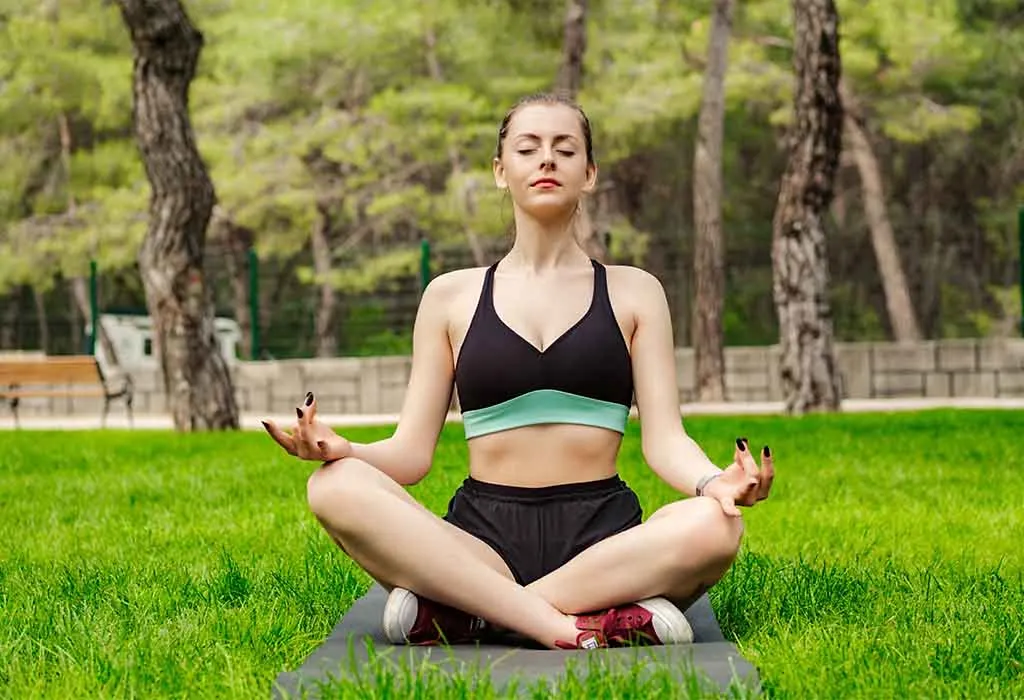
Sukhasana, or Easy Pose, is a simple seated asana that promotes relaxation and mindfulness. It can be practised on an empty stomach and is often held for several minutes to cultivate a sense of calm and centeredness.
How to Do
- Sit on the floor with your legs extended.
- Cross your shins and widen your knees, slipping each foot beneath the opposite knee.
- Relax your feet so their outer edges rest comfortably on the floor and your inner arches settle below the opposite shin.
- Sit with your hands on your knees and your spine straight.
Benefits
Sukhasana helps open the hips, lengthens the spine, and promotes a sense of calm and relaxation. It’s excellent for meditation and improving posture.
9. Trikonasana (Triangle Pose)
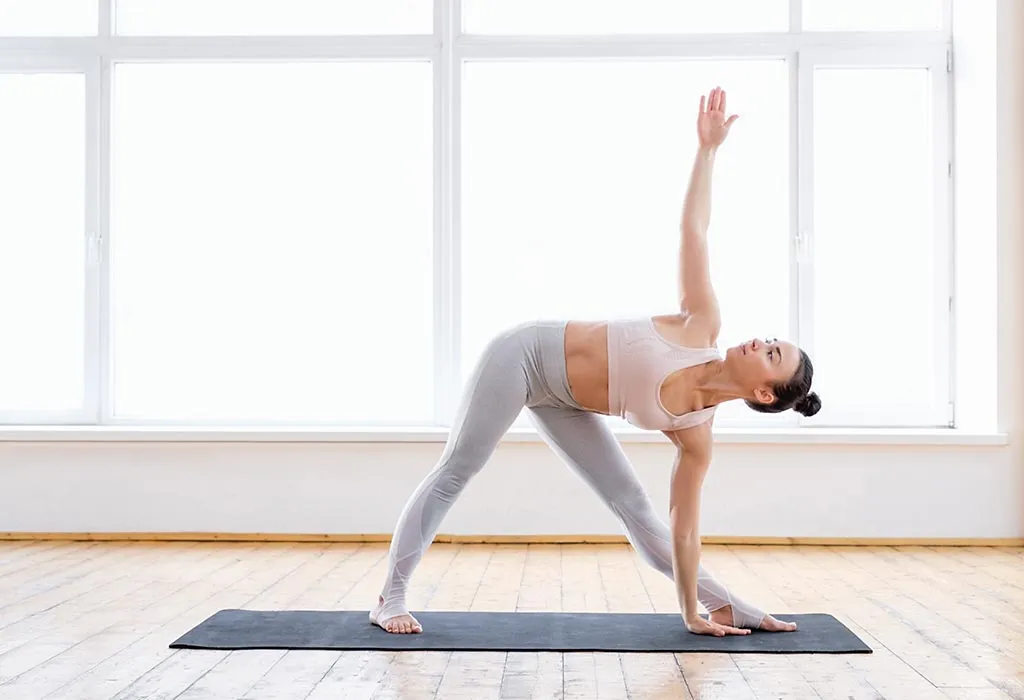
Trikonasana, known as Triangle Pose, is a powerful asana that stretches the legs and improves balance. This pose can be practised on an empty stomach and is typically held for up to 30 seconds to enhance stability and focus.
How to do
- Stand with feet wide apart.
- Turn your right foot out and left foot slightly in.
- Extend your right arm towards the ground and your left arm towards the sky.
- Look up at your left hand and hold for 5-10 breaths, then switch sides.
Benefits
Trikonasana, is a powerful asana that stretches the legs, hips, and spine while improving balance and stability.
10. Paschimottanasana (Seated Forward Bend)
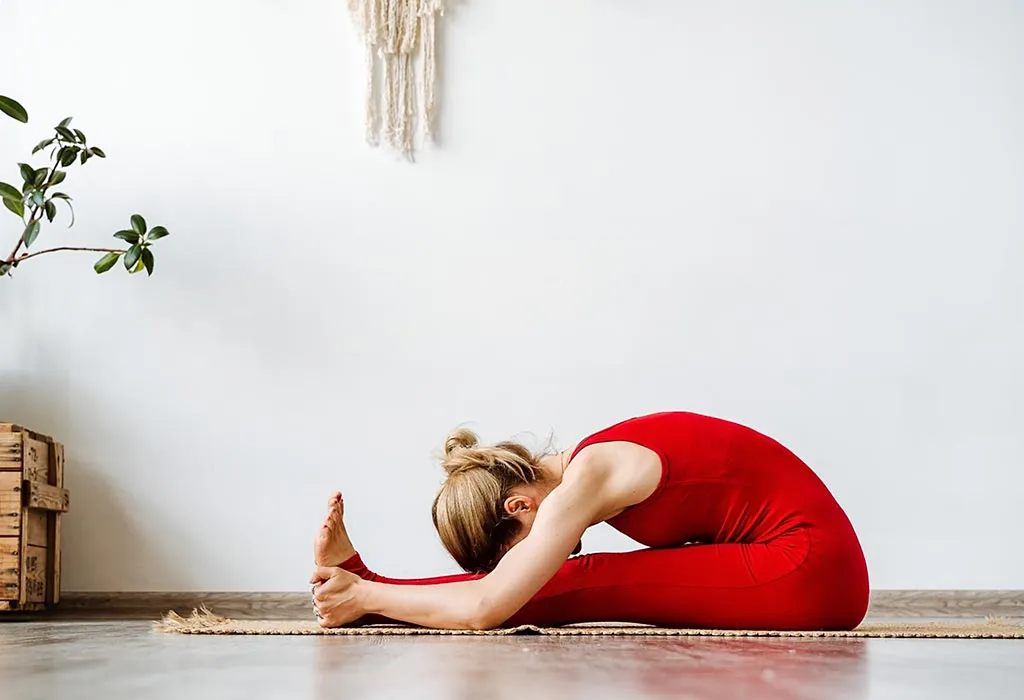
Paschimottanasana, known as Seated Forward Bend, is a calming asana that stretches the spine and hamstrings. It is best practised on an empty stomach and can be held for up to 30 seconds for maximum benefit.
How to Do
- Sit with your legs extended in front of you.
- Inhale and lengthen your spine.
- Exhale as you hinge at your hips, reaching for your feet or shins.
- Hold for several breaths, keeping your spine long.
Benefits
Seated Forward Bend, or Paschimottanasana, is a calming pose that stretches the spine, shoulders, and hamstrings, providing a gentle stretch and promoting relaxation during the first trimester.
11. Malasana (Garland Pose)
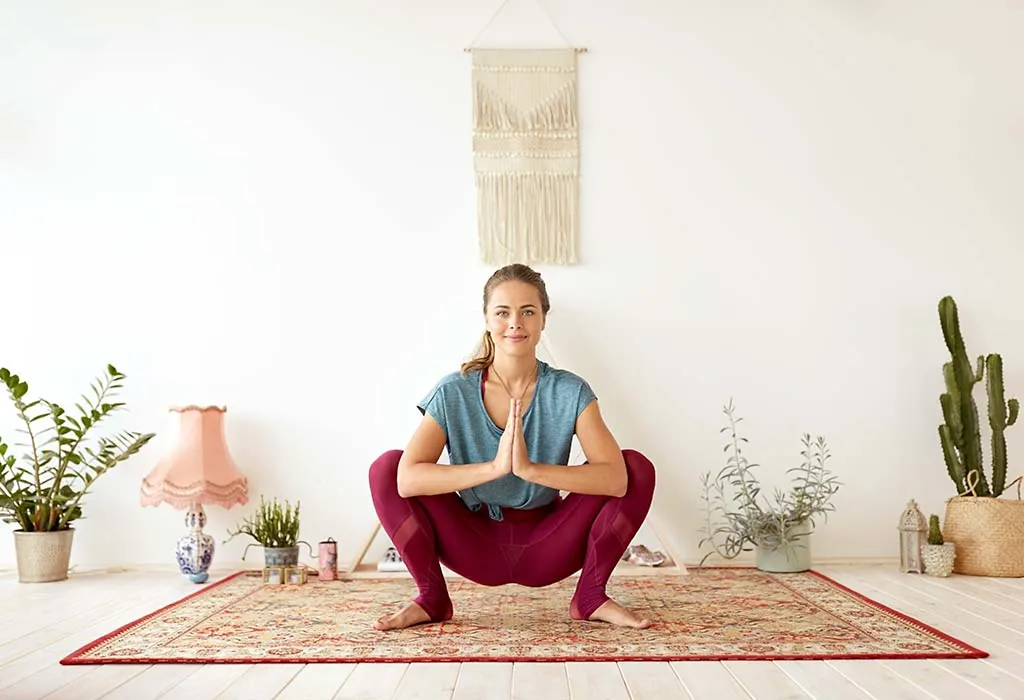
Malasana, or Garland Pose, is a deep squatting asana that opens the hips and stretches the lower back. It can be practised comfortably on an empty stomach.
How to Do
- Stand with your feet wider than hip-width apart, with your toes turned out slightly.
- Squat down, bringing your hips close to the floor.
- Press your elbows against your inner knees and bring your palms together at your chest.
- Hold for several breaths.
Benefits
Garland Pose, or Malasana, is a deep squatting posture that helps to open the hips and stretch the lower back, making it beneficial during pregnancy.
Yoga Poses to Avoid During the First Trimester
Avoid practising the yoga poses stated below in the first trimester of pregnancy –
1. Sun Salutations With Jump-Backs
Sun salutation is a complete exercise in itself and can drain you. Due to the body’s physical demands and energy required by the growing fetus, it’s essential that you rest and avoid anything that exhausts you.
2. Locust Pose
This yoga pose can pressure your belly, which can harm the baby and pregnancy.
3. Boat Pose
Practising boat poses during pregnancy can strain the abdominal muscles and stress the belly.
4. Plough Pose
The plough pose can pressure your core, negatively affecting your health and the baby’s health.
Yoga Tips to Keep in Mind During the First Trimester
Keep these tips in mind when practising yoga asanas during your first trimester:
- If you’re new to yoga, start with simple poses to improve your flexibility. And use props when you feel tired but want to continue practising yoga (3).
- Don’t practice yoga poses that require bending your back, such as plank pose, or anything that twists or puts pressure on the uterus or belly.
- Relax at the end of a class and breathe properly while practising yoga (4).
- Modify the above safe pregnancy yoga asanas as per your comfort level and physical health, and practice under the supervision of a certified teacher.
FAQs
1. How often should I practice yoga during the first trimester?
Practising yoga 3-4 times a week for about 20-30 minutes per session is beneficial. However, listen to your body and adjust the frequency and duration of your practice based on how you feel. Consistency is key, but rest is equally important if you experience fatigue or discomfort (6).
2. Is it necessary to attend a prenatal yoga class, or can I practice at home?
While attending a prenatal yoga class is beneficial because it provides guidance from an experienced instructor and connects you with other pregnant women, practising at home is also possible. If you choose to practice at home, follow a reputable prenatal 1st-trimester yoga video or app and ensure you’re using safe and appropriate poses for your stage of pregnancy.
Incorporating yoga while pregnant in the first trimester can offer many benefits, from alleviating stress and promoting better sleep to easing common pregnancy discomforts and preparing your body for the changes ahead. Keep these tips in mind and practice safely in a quiet, stress-free environment. The key is to stay relaxed and enjoy yourself. Feel free to stop midway and rest if you ever feel discomfort.
References/Resources:
1. Pregnancy Yoga Poses for the First Trimester; The Art of Living; https://www.artofliving.org/in-en/yoga/yoga-sequences-for/pregnancy-yoga-poses-for-the-first-trimester
2. Yoga in pregnancy: Many poses are safer than once thought; Harvard Health Publishing; https://www.health.harvard.edu/blog/yoga-in-pregnancy-many-poses-are-safer-than-once-thought-201512298898
3. Is it safe to exercise in pregnancy?; Tommy’s; https://www.tommys.org/pregnancy-information/im-pregnant/exercise-in-pregnancy/it-safe-exercise-pregnancy
4. Yoga in pregnancy; Tommy’s; https://www.tommys.org/pregnancy-information/im-pregnant/exercise-in-pregnancy/yoga-pregnancy
5. Corrigan. L, Moran. P, McGrath. N, et al.; The characteristics and effectiveness of pregnancy yoga interventions: a systematic review and meta-analysis; PubMed Central; https://www.ncbi.nlm.nih.gov/pmc/articles/PMC8957136/
6. Curtis. K, Weinrib. A, Katz. J; Systematic review of yoga for pregnant women: current status and future directions; PubMed Central; https://www.ncbi.nlm.nih.gov/pmc/articles/PMC3424788/
7. Morgan. J; Yoga and pregnancy: A safe, effective fitness option for moms-to-be; The University of Texas Southwestern Medical Center; https://utswmed.org/medblog/yoga-and-pregnancy/
Also Read:
First Trimester Care in Pregnancy
Safe Exercise during Pregnancy First Trimester
What Food to Eat and Avoid in the First Trimester?
First Trimester of Pregnancy – Symptoms, Body Changes & Diet
Was This Article Helpful?
Parenting is a huge responsibility, for you as a caregiver, but also for us as a parenting content platform. We understand that and take our responsibility of creating credible content seriously. FirstCry Parenting articles are written and published only after extensive research using factually sound references to deliver quality content that is accurate, validated by experts, and completely reliable. To understand how we go about creating content that is credible, read our editorial policy here.









